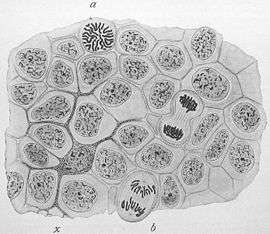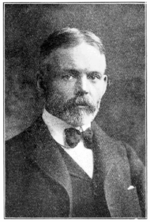Edmund Beecher Wilson
| Edmund Beecher Wilson | |
|---|---|
|
Edmund Beecher Wilson | |
| Born |
October 19, 1856 Geneva, Illinois |
| Died |
March 3, 1939 (aged 82) New York City |
| Fields |
Zoology Genetics |
| Institutions |
Williams College MIT Bryn Mawr College Columbia University |
| Alma mater |
Yale University Johns Hopkins University |
| Known for | XY sex-determination system |
| Influenced | Nettie Stevens[1] |
| Notable awards |
Daniel Giraud Elliot Medal (1925) Linnean Medal (1928) John J. Carty Award (1936) Fellow of the Royal Society[2] |

Edmund Beecher Wilson (19 October 1856 – 3 March 1939) was a pioneering American zoologist and geneticist. He wrote one of the most famous textbooks in the history of modern biology, The Cell.[3][4] He and Nettie Maria Stevens were the first researchers to describe the chromosomal basis of sex, but they conducted their research independently of each other.[5]
Career
Wilson was born in Geneva, Illinois, and graduated from Yale University in 1878. He earned his Ph.D. at Johns Hopkins in 1881.
He was a lecturer at Williams College in 1883–84 and at the Massachusetts Institute of Technology in 1884–85. He served as professor of biology at Bryn Mawr College from 1885 to 1891.
He spent the balance of his career at Columbia University where he was successively adjunct professor of biology (1891–94), professor of invertebrate zoology (1894–1897), and professor of zoology (from 1897).
Wilson is credited as America's first cell biologist. In 1898 he used the similarity in embryos to describe phylogenetic relationships. By observing spiral cleavage in molluscs, flatworms and annelids he concluded that the same organs came from the same group of cells and concluded that all these organisms must have a common ancestor. He was elected a Fellow of the American Academy of Arts and Sciences in 1902.[6]
He also discovered the chromosomal XY sex-determination system in 1905—that males have XY and females XX sex chromosomes. Nettie Stevens independently made the same discovery the same year.[5]
In 1907, he described, for the first time, the additional or supernumerary chromosomes, now called B-chromosomes. The same year he became a foreign member of the Royal Netherlands Academy of Arts and Sciences.[7]
Professor Wilson published many papers on embryology, and served as president of the American Association for the Advancement of Science in 1913.
For his volume, The Cell in Development and Inheritance, Wilson was awarded the Daniel Giraud Elliot Medal from the National Academy of Sciences in 1925.[8] The American Society for Cell Biology annually awards the E. B. Wilson Medal in his honor.[9]
Sutton and Boveri
In 1902 and 1903 Walter Sutton suggested that chromosomes, which segregate in a Mendelian fashion, are hereditary units: "I may finally call attention to the probability that the association of paternal and maternal chromosomes in pairs and their subsequent separation during the reducing division … may constitute the physical basis of the Mendelian law of heredity".[10] Wilson, who was Sutton's teacher and Boveri's friend, called this the "Sutton-Boveri Theory".
1902–1904: Theodor Heinrich Boveri (1862–1915), a German biologist, made several important contributions to chromosome theory in a series of papers, finally stating in 1904 that he had seen the link between chromosomes and Mendel's results in 1902 (although this is not documented in his publications).[11] He said that chromosomes were "independent entities which retain their independence even in the resting nucleus... What comes out of the nucleus is what goes into it".
Works
- An Introduction to General Biology (1887), with W. T. Sedgwick
- The Embryology of the Earthworm (1889)
- Amphioxus, and the Mosaic Theory of Development (1893)
- Atlas of Fertilization and Karyokinesis (1895)
- The Cell in Development and Inheritance (1896; second edition, 1915; third edition, 1925)
-
 This article incorporates text from a publication now in the public domain: Gilman, D. C.; Thurston, H. T.; Colby, F. M., eds. (1905). "article name needed". New International Encyclopedia (1st ed.). New York: Dodd, Mead.
This article incorporates text from a publication now in the public domain: Gilman, D. C.; Thurston, H. T.; Colby, F. M., eds. (1905). "article name needed". New International Encyclopedia (1st ed.). New York: Dodd, Mead.
References
- ↑ "Nettie Maria Stevens (1861–1912)". The Marine Biological Laboratory. Archived from the original on March 31, 2013. Retrieved August 18, 2013.
- ↑ Morgan, T. H. (1940). "Edmund Beecher Wilson. 1856–1939". Obituary Notices of Fellows of the Royal Society. 3 (8): 123–126. doi:10.1098/rsbm.1940.0012.
- ↑ Wilson E.B. 1896; 1900; 1925. The cell in development and inheritance. Macmillan. The third edition ran to 1232 pages, and was still in use after World War II.
- ↑ Sturtevant A.H. 1965. A history of genetics. Harper & Row, N.Y. p33
- 1 2 Brush, Stephen G. (June 1978). "Nettie M. Stevens and the Discovery of Sex Determination by Chromosomes". Isis. 69 (2): 162–172. JSTOR 230427.
- ↑ "Book of Members, 1780–2010: Chapter W" (PDF). American Academy of Arts and Sciences. Retrieved 10 April 2011.
- ↑ "Edm. B. Wilson (1856–1939)". Royal Netherlands Academy of Arts and Sciences. Retrieved 20 July 2015.
- ↑ "Daniel Giraud Elliot Medal". National Academy of Sciences. Archived from the original on 1 August 2012. Retrieved 22 August 2013.
- ↑ E. B. Wilson award page at ASCB.org
- ↑ Sutton, W.S. (1902). On the morphology of the chromosome group in Brachystola magna. Biol. Bull. 4: 24–39, p. 39.
- ↑ Boveri T. 1904. Ergebnisse uber die Konstitution der chromatischen Substanz des Zellkerns. Fischer, Jena.
Bibliography
- Al-Awqati, Q. 2002. Edmund Beecher Wilson: America's First Cell Biologist. Living Legacies, Columbia University.
- Gilbert, S. F. 2003. Edmund Beecher Wilson and Frank R. Lillie and the relationship between evolution and development, Developmental Biology, Seventh edition, Sinauer
- Kingsland, S. E. (2007). "Maintaining continuity through a scientific revolution: A rereading of E. B. Wilson and T. H. Morgan on sex determination and Mendelism". Isis; an international review devoted to the history of science and its cultural influences. 98 (3): 468–488. doi:10.1086/521153. PMID 17970422.
- Dröscher, A. (2002). "Edmund B. Wilson's the cell and cell theory between 1896 and 1925". History & Philosophy of the Life Sciences. 24 (3–4): 357–357. doi:10.1080/03919710210001714473.
- Baxter, A. L. (1977). "E. B. Wilson's "destruction" of the germ-layer theory". Isis; an international review devoted to the history of science and its cultural influences. 68 (243): 363–374. PMID 336580.
- Baxter, A. L. (1976). "Edmund B. Wilson as a preformationist: Some reasons for his acceptance of the chromosome theory". Journal of the History of Biology. 9 (1): 29–57. doi:10.1007/BF00129172. PMID 11615633.
- Wilson, Edmund B. (1907). "The supernumerary chromosomes of Hemiptera". Science. 26 (677): 870–71. doi:10.1126/science.26.677.870-a.
External links
| Wikimedia Commons has media related to Edmund Beecher Wilson. |
- Works by Edmund Beecher Wilson at Project Gutenberg
- Works by or about Edmund Beecher Wilson at Internet Archive
